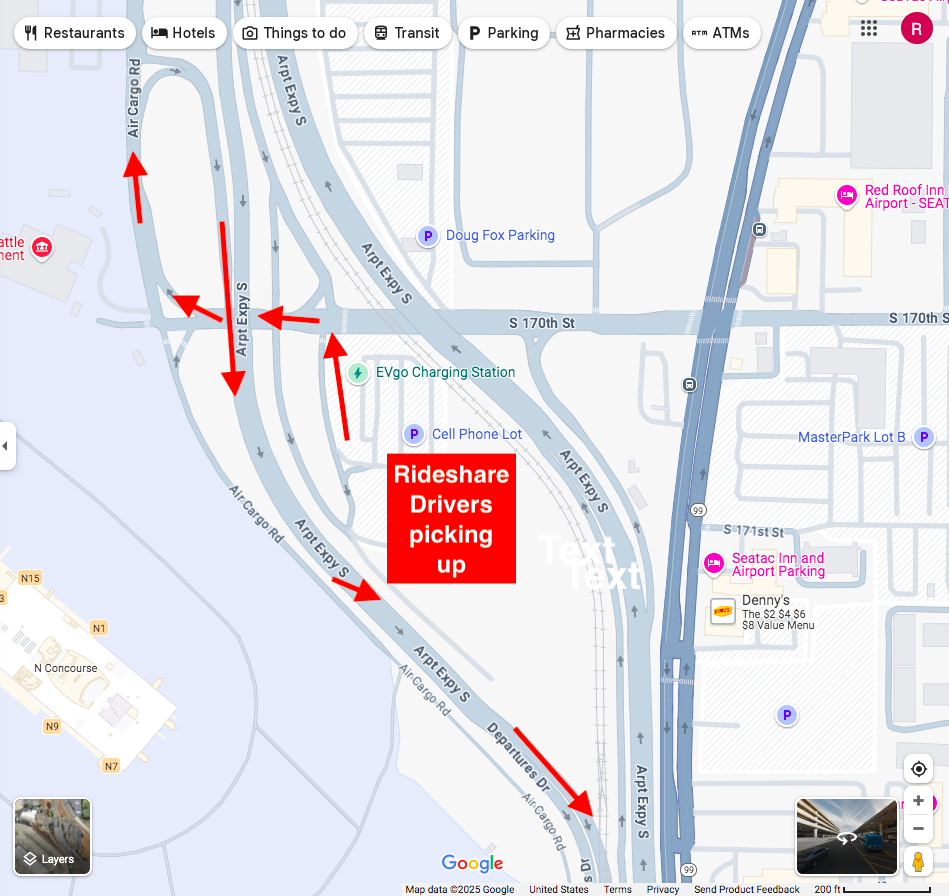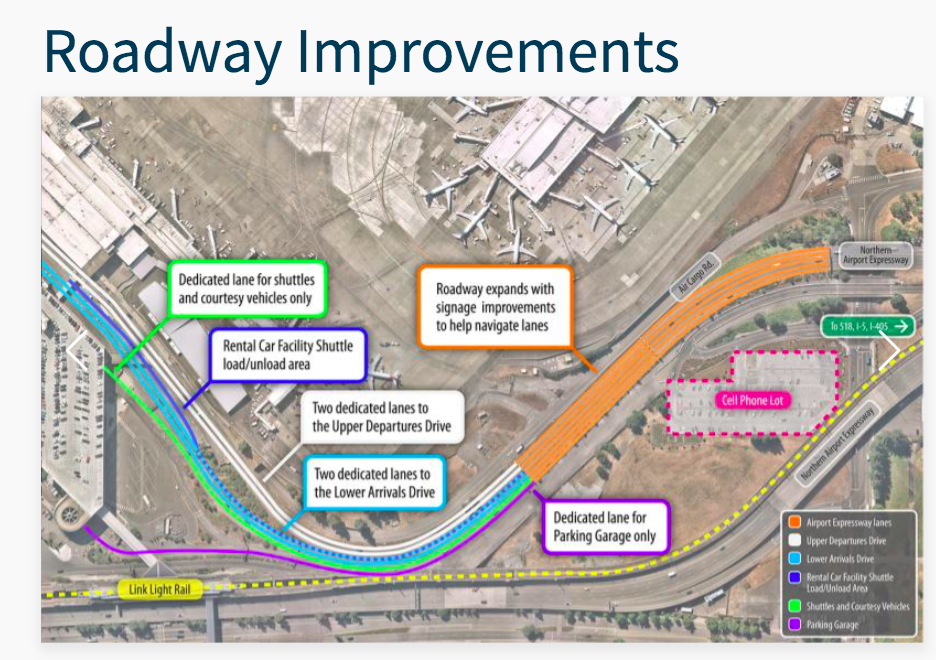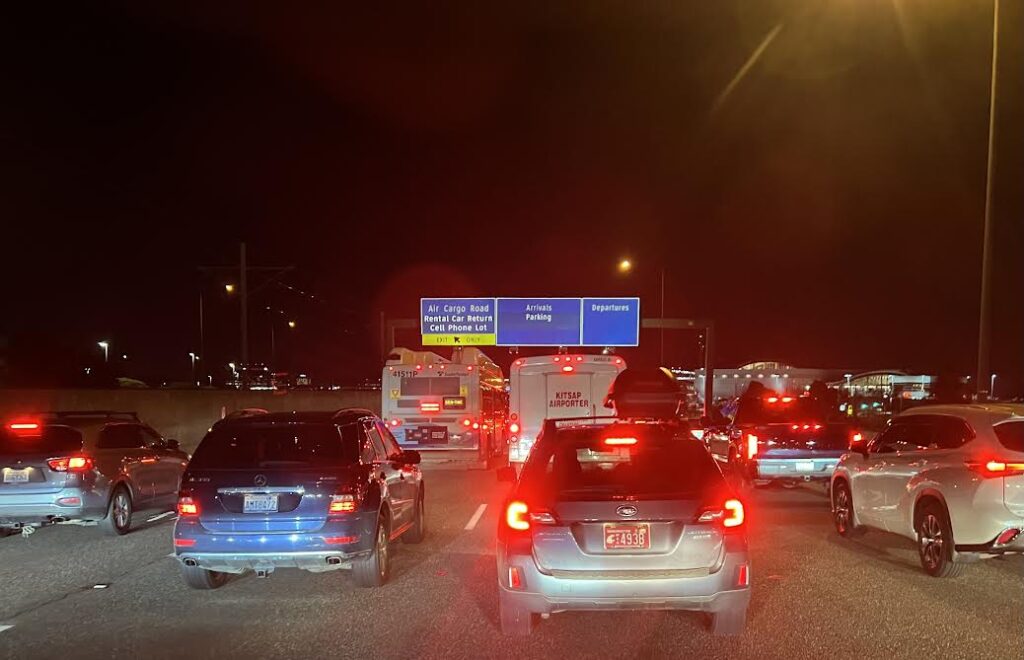
The view as my wife and I crawl for 25 minutes in a typical SeaTac airport arrival traffic jam last week
I’m excited about an arriving visitor this week, but I’m already dreading the traffic jam I know I’ll encounter at SeaTac Airport when we pick her up. While Port of Seattle leaders will give the excuse that these jams can’t be helped because of the large number of travelers, the reality is the Port created this problem with the poor traffic planning of the cell phone lot.
The 1960 SeaTac airport approach was brilliantly engineered for high volumes: three dedicated express lanes approaching the airport, growing into four — two departure lanes and two arrival lanes. Each of these roads double from two to four lanes at the terminal with the addition of curbside pick-up/drop-off lanes. The elegant design could smoothly handle today’s volume of travelers, if Port officials had not implemented the “rideshare weave” that requires 25% of the drivers to cut across four lanes of the other 75% of drivers in the last critical quarter mile of the approach.
As Rideshare became more prevalent –now estimated at about 25% of airport passengers– Sea-Tac and other airports across the nation set up waiting areas for drivers who are picking up. When drivers are notified their passengers are in the pick-up spot, they swiftly proceed to the designated location, and wisk their passenger to their destination.
Except at SeaTac Airport. Here at SeaTac, designers located the cell phone lot such that every rideshare driver must merge onto the right lane of the airport expressway, and then during the next quarter mile move four lanes to the left, before exiting into a typically backed-up lane into the parking garage. This flawed configuration has been snarling evening traffic into SeaTac for years, and can seriously impact all passengers arriving or departing from SeaTac airport by cars, busses, and courtesy vans (whether or not they are rideshare passengers).

Rideshare drivers picking up passengers, and other cell phone lot users, follow this path when informed that their passengers are ready. It requires a merge followed by three quick lane changes across the airport expressway. All arriving airport traffic is slowed by these lane changes.
As rideshare drivers negotiate the multitude of lane changes, often hugging the right lane as long as possible before aggressively moving left, the entire airport access road comes to a standstill– not because of volume (as the Port states) but because the Port officials implemented the dangerous weave in the traffic design about ten years ago.
This nightly traffic jam can easily add 20-30 minutes or more to a pickup or drop-off time, stressing travel schedules and making it harder to coordinate driver and passenger connections. When an arriving motorist finally gets past the weave, the traffic into the arrivals or departure curbs usually flow reasonably well, except where it gets blocked by idling drivers whose passengers have not arrived, and refuse to go around again because they can’t tolerate the traffic jam a second time. The weaving traffic jams trigger additional scofflaw activity near the airport entrance, where scores of drivers are pulled over on the shoulder next to “no-parking” signs in an ad-hoc cell phone lot, preferring to risk a ticket over the traffic weave from the designated cell-phone lot.
The airport clearly needs to find a way to NOT have to move all the rideshare drivers from the right side to the left side. But instead of working this, something that could have been done years ago, the Port spent $13.5 million improving circulation into and around the cell phone lot in 2022. And next the port will spend $79.3 million widening the airport expressway, and making the backed-up single lane into the parking garage longer. All this new additional pavement will provide more space for jammed up cars to queue, but won’t address the weave problem at the root of the backup.

New pavement will be added with roadway improvements in 2026 for $79.3 million, but the Cell Phone lot users will still have to weave across all lanes of arriving airport traffic
Together, we taxpayers are currently putting about five billion dollars into Sea-Tac Airport expansion, so it would be nice if we could get to the airport reliably. As I sit stewing in these jam-ups, I blame the Seattle Port Commissioners more than anyone else for the traffic mess. They have ultimate responsibility to make our airport usable, and the buck stops at their office. They could have solved this by now, and instead they are banking on a 2026 fix that probably won’t work.

Departing passengers fret about missing their flights, while drivers picking up loved ones wonder how long they will be waiting in the cold, in this typical evening traffic jam at Sea-Tac Airport. Evening brings the worst jams because aircraft arrivals –and ride share pickups– are typically at their highest.


Recent Comments